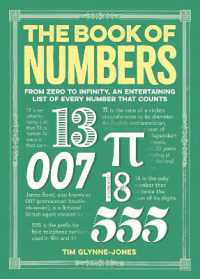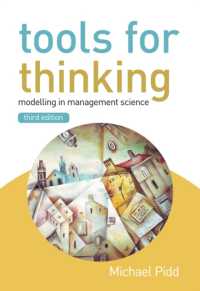- ホーム
- > 洋書
- > 英文書
- > Science / Mathematics
Full Description
Presents theoretical, computational, and applications of collision-induced phenomena with emphasis on the treatment of physical and chemical kinetics using quantum molecular dynamics
Quantum Molecular Dynamics provides a state-of-the-art overview of molecular collisions and kinetics rates in energy-transfer and reactivity phenomena in gases. Grounded in the quantal theory of scattering and its semiclassical limits, this comprehensive volume covers key concepts and theory, computational approaches, and various applications for specific physical systems.
Detailed chapters describe elastic, inelastic and reactive collisions, that lead to energy transfer and electronic transitions, atomic rearrangements, and more. Starting from the electronic structure and atomic conformation of molecules, the text proceeds from introductory material to advanced modern treatments relevant to technologies for new materials, the environment, biological phenomena, and energy and fuels production.
Provides a thorough introduction with realistic intermolecular forces
Covers cross sections and thermal rates of molecular collisions and comparisons with experimental results
Examines energy transfer and reactivity phenomena mediated by molecular collisions
Discusses many-atom scattering theory as an introduction to more advanced descriptions
Presents the computational aspects required to calculate and compare cross-sections with experimental data
Includes worked examples and applications to different physical systems
Quantum Molecular Dynamics is an important resource for researchers and advanced undergraduate and graduate students in physical, theoretical, and computational chemistry, chemical physics, materials science, as well as chemists, engineers, and biologists working in the energy and pharmaceutical industries and the environment. From the author of Molecular Interactions: Concepts and Methods (Wiley, 2020), this new book builds on and extends the foundational concepts introduced in that earlier work.
Contents
Preface
1 Collisional Phenomena, Cross Sections and Rates 1
1.1 Electronic and Nuclear Motions in Collisional Phenomena 2
1.2 Collisional Cross Sections......5
1.3 Quantal Description of Collisions 9
1.4 Examples of Physical Systems and Phenomena. 11
1.5 Transport, energy relaxation and reaction rates in gases 19
1.6 Concepts and methods in the quantal modelling 20
References 21
FIGURES 25
INDEX 39
2 Elastic Collisions 1
2.1 Elastic Collision Cross Sections 1
2.2 Integral equation and approximations 7
2.3 Partial-wave analysis 14
2.4 Numerical methods for scattering 22
2.5 Examples 30
References 32
FIGURES 35
INDEX 44
3 Inelastic Collisions: Dynamics 2
3.1 Inelastic collision Cross Sections 2
3.2 Coupled-Channel Equations 13
3.3 Matrix form of partial-wave equations 16
3.4 Collisions Involving Two Coupled Channels 20
3.5 Distorted-Waves Treatment 23
3.6 Optical potential models 26
Bibliography 29
FIGURES 31
Figure 3.1 31
INDEX 33
4 Inelastic Collisions: Adiabatic Energy Transfer 2
4.1 Adiabatic energy transfer cross sections 2
4.2 Numerical Methods 10
4.3 Electronically Adiabatic Rotational Transitions 17
frame 21
4.4 T-R transfer calculations and comparisons with experimental values 24
4.5 Translational-Rotational-Vibrational (T-R-V) transfer 29
References 36
FIGURES 39
Figure 4.1 39
Figure 4.2 40
Figure 4.3 42
Figure 4.4 43
Figure 4.5 44
Figure 4.6 45
Figure 4.7 46
INDEX 47








